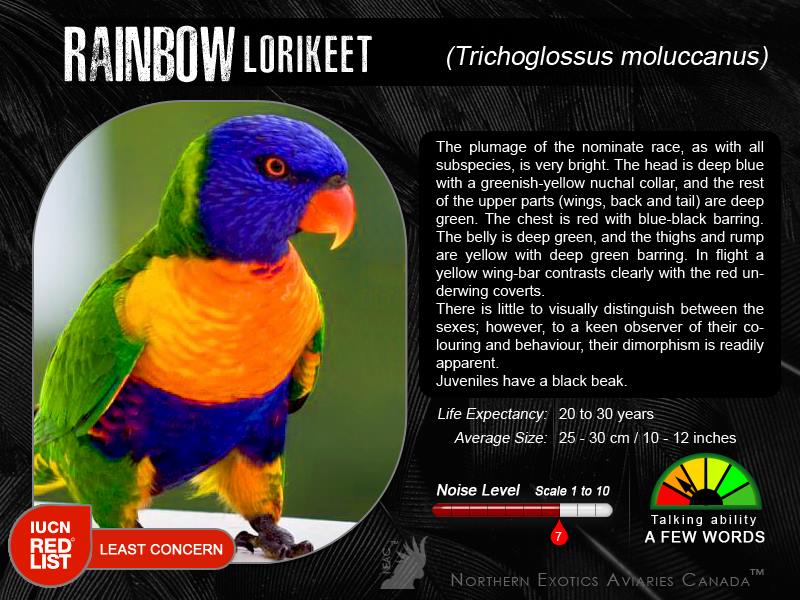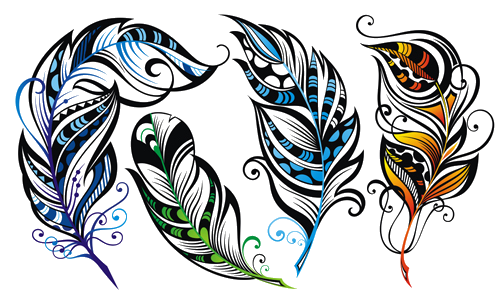Rainbow Lorikeet - Trichoglossus Moluccanus - Least Concern
The rainbow lorikeet (Trichoglossus moluccanus) is a species of parrot found in Australia. It is common along the eastern seaboard, from northern Queensland to South Australia. Its habitat is rainforest, coastal bush and woodland areas. Several taxa traditionally listed as subspecies of the rainbow lorikeet are now treated as separate species.
The rainbow lorikeet has often included the red-collared lorikeet (T. rubritorquis) as a subspecies, but today most major authorities consider it separate. Additionally, a review in 1997 led to the recommendation of splitting off some of the most distinctive taxa from the Lesser Sundas as separate species, these being the scarlet-breasted lorikeet (T. forsteni), the marigold lorikeet (T. capistratus) and the Flores lorikeet (T. weberi). This is increasingly followed by major authorities.
Description: The rainbow lorikeet is a medium-sized parrot, with the length ranging from 25 to 30 cm (10 to 12 in), including the tail. The weight varies from 75 to 157 g (2.6–5.5 oz). The plumage of the nominate race, as with all subspecies, is very bright. The head is deep blue with a greenish-yellow nuchal collar, and the rest of the upper parts (wings, back and tail) are green. The chest is orange/yellow. The belly is deep blue, and the thighs and rump are green. In flight a yellow wing-bar contrasts clearly with the red underwing coverts.
There is little to visually distinguish between the sexes; however, to a keen observer of their colouring and behaviour, their dimorphism is readily apparent. Juveniles have a black beak, which gradually brightens to orange in the adults.
The markings of Trichoglossus moluccanus resemble those of the Coconut Lorikeet (Trichoglossus haematodus), but with a blue belly and a more orange breast with little or no blue-black barring.
Dimorphism: Unlike the eclectus parrot, rainbow lorikeets do not have any immediately discernible dimorphic traits. Males and females look identical, and surgical sexing by a vet or DNA analysis of a feather is used to determine the sex of an individual. Upon closer observation of their colouring, size and behaviour, however, it is possible to determine the sex of a rainbow lorikeet. This process is made easier when one observes them in pairs; however the general rules are that a male will have a greater concentration of dark orange on his breast as opposed to the more pronounced bleeding of yellow into orange of a female. The male will also be more robust across the breast and traditionally have a thicker, more square head whilst the female sports a more rounded visage. When feeding in a flock during breeding season, the male will often puff up and produce a threatening display, hopping around his partner as she feeds and ensuring that competitors for food do not interrupt her ingestion of food.
Behavior: Rainbow lorikeets often travel together in pairs and occasionally respond to calls to fly as a flock, then disperse again into pairs. Rainbow lorikeet pairs defend their feeding and nesting areas aggressively against other rainbow lorikeets and other bird species. They chase off not only smaller birds such as the noisy miner and the little wattlebird, but also larger birds such as the Australian magpie.
Diet: Rainbow lorikeets feed mainly on fruit, pollen and nectar, and possess a tongue adapted especially for their particular diet. The end of the tongue is equipped with a papillate appendage adapted to gathering pollen and nectar from flowers. Nectar from eucalyptus is important in Australia, other important nectar sources are Pittosporum, Grevillea, Spathodea campanulata (African tulip-tree), and Metroxylon sagu (sago palm). In Melanesia coconuts are very important food sources, and rainbow lorikeets are important pollinators of these. They also consume the fruits of Ficus, Trema, Mutingia, as well as papaya and mangoes already opened by fruit bats. They also eat crops such as apples, and will raid maize and sorghum. They are also frequent visitors at bird feeders placed in gardens, which supply store-bought nectar, sunflower seeds, and fruits such as apples, grapes and pears.
In many places, including campsites and suburban gardens, wild lorikeets are so used to humans that they can be hand-fed. The Currumbin Wildlife Sanctuary in Queensland, Australia, is noted for its thousands of lorikeets. Around 8am and 4pm each day the birds gather in a huge, noisy flock in the park's main area. Visitors are encouraged to feed them a specially prepared nectar, and the birds will happily settle on people's arms and heads to consume it. Wild rainbow lorikeets can also be hand-fed by visitors at Lone Pine Koala Sanctuary in Brisbane, Queensland, Australia.
Semi-tame lorikeets are common daily visitors in many Sydney backyards, though many people, ignorant of their dietary requirements, feed them bread or bread coated with honey. This is an inadequate source of the nutrients, vitamins and minerals that the rainbow lorikeet requires and can lead to health and feather formation issues in young lorikeets. Packet mixes with a nutritional mix suitable for feeding lorikeets are generally available from vets and pet stores.
Breeding: In southern Australia, breeding usually occurs from late winter to early summer (August to January). Elsewhere in Australia, breeding has been recorded in every month except March, varying from region to region due to changes in food availability and climate. Nesting sites are variable and can include hollows of tall trees such as eucalypts, palm trunks, or overhanging rock. One population in the Admiralty Islands nests in holes in the ground on predator-free islets. Pairs sometimes nest in the same tree with other rainbow lorikeet pairs, or other bird species. The clutch size is between one and three eggs, which are incubated for around 25 days. Incubation duties are carried out by the female alone.
Rainbow lorikeets are mostly monogamous and remain paired for long periods, if not for life.

Psittaciformes, The Parrot Index, a part of Phoenix Feathers © 2016 - 2023
Page last updated: 12/24/23
Phoenix Feathers

